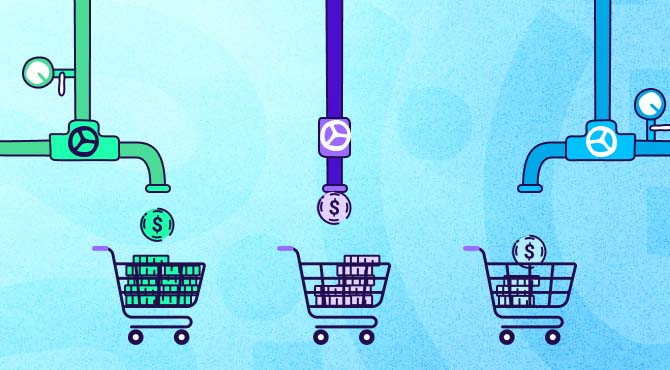Everything you need to know about commerce media


The online advertising space is changing (rapidly) and commerce media has a lot to do with it. Since 2019, we’ve seen companies such as Target, Home Depot, and Amazon launch new advertising networks to monetize their first-party data and increase profits. Is it working? Very much so. Brands are seeing 3-5x ROAS by being able to advertise better and smarter, and retailers are witnessing $20bn to $30bn in brand spend per year (McKinsey). Let’s take a step back and get to know commerce media better and why you have to understand it as an online marketer.
What is commerce media?

A commerce media network enables brands with robust first-party data to provide targeted ads and precise closed-loop measurement capabilities to advertisers.
For advertisers lacking extensive first-party data, purchasing ad space within a commerce media network introduces fresh avenues to engage consumers, assess and enhance campaign performance, and access valuable insights through collaborative data efforts.
There are three parties involved in commerce media:
1. Advertisers – These are brands and advertisers (and their agencies) that are on the demand side of the commerce media system. Their goal is to create successful ad campaigns that are aimed at the right consumers at the right stage of their purchase journey/funnel. In the crowded digital landscape, brands are constantly looking for ways to stay ahead of their competitors, both with better targeting as well as using advanced technologies to create interesting and compelling advertisements.
2. Media owners – These are the publishers and retailers that provide the supply side of the commerce media chain. Their goal is to monetize their first-party data in a secure manner to increase profits. Privacy and security are absolutely critical for media owners, as they are relying on their own data to help brands create successful campaigns.
3. Consumers – Online shoppers and buyers who are exposed to online ads on a regular basis. These shoppers want to see relevant ads for products that they are interested in but also don’t want to feel that their privacy is being invaded.
These three components together make up the commerce media ecosystem. This ecosystem is responsible for displaying relevant ads for products and services in the optimal location in the buyer journey. Commerce media links ads and specific products straight to transactions, making the entire process seamless and easy for all involved
How does commerce media work?

Commerce media combines content, commerce, and media, to create an engaging and enjoyable shopping experience for consumers. It requires sharing first-party data between brands and publishers in a privacy-secure way (often through a data clean room).
Commerce media is an effective and exciting way to advertise because it’s smart and attractive to all three sides involved. The large amounts of first-party data that the media owners possess allow brands to advertise to new (and specific) markets at various parts of the funnel.
There are various tactics used in commerce media including:
- Dynamic ad formats are used in different networks, adapted for user preferences and different technologies. Dynamic ads can also adjust to display the most up-to-date and accurate information.
- Direct transaction capabilities in dynamic ads gives consumers the option to make purchases seamlessly within the ad experience.
- Influencer marketing is partnering with influential content creators to give brands further reach and credibility to promote and drive sales.
- Augmented reality experiences create immersive and interactive product experiences, enabling consumers to visualize products in their own environments before clicking the purchase button.
- Personalized recommendations are a major part of commerce media. Utilizing consumer data and machine learning algorithms allows brands to target users based on individual preferences, purchase history, and browsing behavior.
Commerce media vs. retail media
It’s not surprising that people often confuse the concepts of retail media and commerce media. While they are connected, the terms can not be used interchangeably.
Retail media refers to advertising opportunities that retailers provide to brands and marketers. The goal here is to monetize first-party data for retailers and may include ads on a retailer’s website, targeted emails or push notifications, and in-store advertising. The key point in retail media is that the advertising is done through the retail network, and major brands such as Amazon and Target have built successful networks using this method.
Commerce media includes retail media methods, but is a much broader term and practice. This is because commerce media includes super apps, travel sites, food delivery companies, etc. to combine content and commerce into one. This enables both brands and retailers to reach their desired audiences.
Think of it this way: all retail media is commerce media, but not all commerce media is retail media.
Why is commerce media important?
With the growing popularity of online platforms and apps, both brands and media owners need to embrace commerce media. Let’s look at the benefits of commerce media for both.
Brands

- Increased ROAS – Commerce media allows brands to reach consumers at multiple touchpoints along the shopping journey, leading to high conversion rates and sales.
- Non-endemic sales opportunities – The chance for brands to advertise and sell products through channels and platforms beyond their traditional reach which can increase market share and drive brand awareness..
- Broaden media mix – Brands are able to broaden their media mix and explore new advertising channels, including product listings, shoppable ads, and influencer marketing campaigns in an effort to reach and engage consumers more effectively leading to higher frequency of purchase and customer LTV.
- Delivers a more personalized experience – Brands can give consumers a better and more personalized experience by targeting them with relevant product recommendations and offers based on their browsing and purchase history across multiple touchpoints.
Retailers

- Additional revenue streams – Commerce media gives retailers the chance to monetize their digital properties and consumer touchpoints through advertising opportunities for brands.
- Increased basket size – Retailers taking advantage of these advertising opportunities can encourage shoppers to pay for more goods with each purchase and to make more purchases in general.
- LTV from advertising – The increased value of adding more touchpoints for shoppers is always helpful in the world of ecommerce. Extra value from this advertising consumption will make its way to your bottom line.
The potential challenges of commerce media
We’ve explored the benefits of commerce media and the way it is changing the marketing scene. Let’s take a look at a few of the potential challenges of commerce media.
- Data and privacy concerns- Naturally, any company that is sharing its first-party data will have security concerns. As commerce media depends on this data, media owners and brands may be skeptical to share their data. Improper use of data may also have legal repercussions and lead to damaged brand reputation. This is why it is critical to use a trusted platform for commerce media that includes secure data clean rooms and robust data governance protocols.

- Complexity and integration challenges – To successfully run a commerce media campaign, various platforms, technologies, and data sources must be connected (often across multiple touchpoints). This can be specifically challenging for companies using legacy software.
- Measurement difficulties – It can be difficult at times to measure the impact of a campaign. Traditional attribution models may not be able to understand and capture the data of these complex, cross-channel experiences, which can lead to inaccuracies.
- Potential ad fatigue on the consumer side – While technology today allows us to target customers more easily at the exact right part of the funnel, the market is also becoming more and more competitive and saturated. If consumers feel that they are being overwhelmed with ads, they may lose interest or feel frustrated.
These challenges and others highlight the need for brands and media owners to choose the right platform to run their commerce media campaigns, to limit frustration as well as potentially damaging situations.
The future of commerce media
Commerce media is rapidly evolving, and several trends are set to shape its growth and impact in the coming years.
- The impact of AI – AI technologies like natural language processing (NLP), computer vision, and machine learning will allow brands to offer more personalized and contextual advertising experiences.
- The use of data clean rooms – This secure environment allows brands and retailers to share and analyze customer data without directly sharing personally identifiable information (PII). This is critical for successful commerce media.
- Consumers looking for a more personalized experience – As technology advances, not only are brands looking for more personalized experiences, so are customers. Consumers expect to see relevant ads along their buyer journey, and commerce media is a great solution to meet this expectation.
- The growth of social commerce and live shopping experiences – Platforms like Instagram, TikTok, and live streaming services are becoming important channels for brands to showcase their products, engage with consumers, and drive sales through integrated commerce media solutions.
The depreciation of cookies and Google’s Advertising ID (GAID)

The potential end of cookies and GAID are leading the industry toward a more privacy-centric approach. With cookies and GAID having served as the backbone of paid digital advertising, companies have to turn to new methods to track, target, and measure across their websites and apps.
With growing privacy concerns and regulatory changes, Google and other major players in the field are phasing out their identifiers. This is where brands are seeing new challenges, trying to understand how they will advertise and measure effectively. Commerce media has emerged as an interesting and effective solution, by using first-party data, in a privacy-compliant environment.
This shift has the potential to change the digital advertising landscape completely in the coming years.
AppsFlyer and commerce media
AppsFlyer DCP (Data Collaboration Platform) gives both brands and media owners the opportunity to dive into the world of commerce media while keeping their data safe.
The platform, based on our data clean room, puts privacy first, making sure that first-party data from both sides stays in the right hands. After connecting the right brands and media owners, our measurement tools make sure that campaigns are fully transparent, so that everyone involved can see the (great!) results.
Key takeaways
- Commerce media is a relatively new form of digital advertising that combines content, commerce, and media to create a seamless and engaging shopping experience for consumers.
- Benefits for brands include increased ROAS, non-endemic sales opportunities, broader media mix, and personalized consumer experiences.
- Benefits for retailers include additional and diversified revenue streams.
- Future trends shaping commerce media include AI for personalization, data clean rooms, the deprecation of cookies/GAID, consumer demand for personalization, and the rise of social commerce.
- AI, data clean rooms, and personalization will be key drivers for the growth of commerce media in the coming years.












